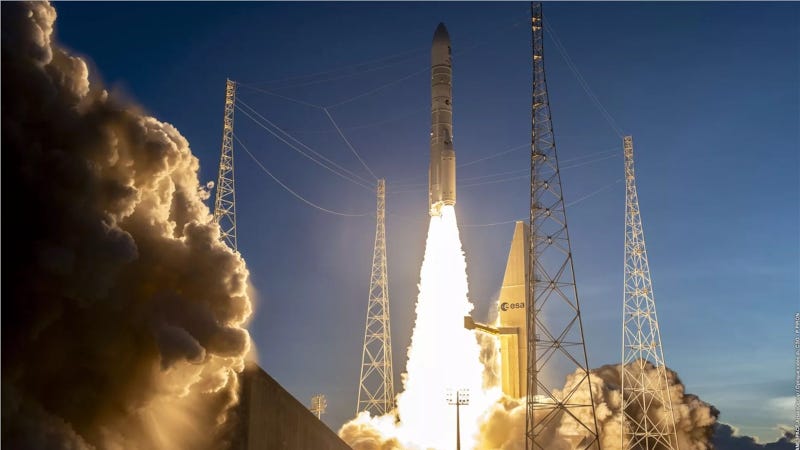Copernicus Sentinel-1D Satellite Placed in Orbit
Will Provide an All-Weather Day-And-Night Supply of Imagery of Earth’s Surface
Ariane 6 lifted off from Europe’s Spaceport Tuesday evening carrying the Copernicus Sentinel-1D satellite. With this third commercial flight, Ariane 6, the European heavy-lift launcher operated by Arianespace, successfully placed Sentinel-1D into Sun-synchronous orbit (SSO) at an altitude of 693 km (≈430 miles). Spacecraft separation occurred 34 minutes after lift-off.
“This launch on board Ariane 6 is an important one for ESA, as it completes the Copernicus Sentinel-1 mission.” Simonetta Cheli, ESA
The Sentinel-1 mission provides radar vision for the Copernicus Earth observation program. Sentinel-1D is the last of the first generation of Copernicus satellites.
“Tonight, Arianespace has successfully launched the EU’s Copernicus Sentinel-1D satellite, on board Ariane 6. With this mission, Arianespace has now delivered seven Sentinel satellites for the emblematic Copernicus program dedicated to the environment - underscoring our commitment to using space for the benefit of life on Earth, while supporting Europe’s significant ambitions in space,” said David Cavaillolès, CEO of Arianespace. “We express our gratitude towards the European Commission, the European Space Agency and all our counterparts for their unique trust and collaboration.” David Cavaillolès added: “This fourth successful flight for Ariane 6 marks another significant milestone achieved together with our industrial partners, all contributing to this impressive ramp-up.”
The Sentinel-1 mission delivers high-resolution synthetic aperture radar (SAR) images of Earth’s surface whenever needed, in all weather, 24/7. This service is used by disaster response teams, environmental agencies, maritime authorities, climate scientists, and the wider Earth observation user community worldwide, who depend on frequent updates of critical data.
“This launch on board Ariane 6 is an important one for ESA, as it completes the Copernicus Sentinel-1 mission – soon Sentinel-1D will be commissioned and fully operational, together with Sentinel-1C,” said Simonetta Cheli, Director of ESA’s Earth Observation Programs. “The continuity of service this provides for the EU Space Program is vital for addressing the global challenges we face. Citizens will benefit from the contribution this mission makes to scientific understanding of our environment – by providing accurate, reliable and actionable radar data on movements in our ice sheets, on our forest ecosystems, ground movements and much more.”
Sentinel-1D will join its twin, Sentinel-1C. When fully commissioned, it will replace Sentinel-1A, which has been in service for more than 11 years, well beyond its planned lifetime.



